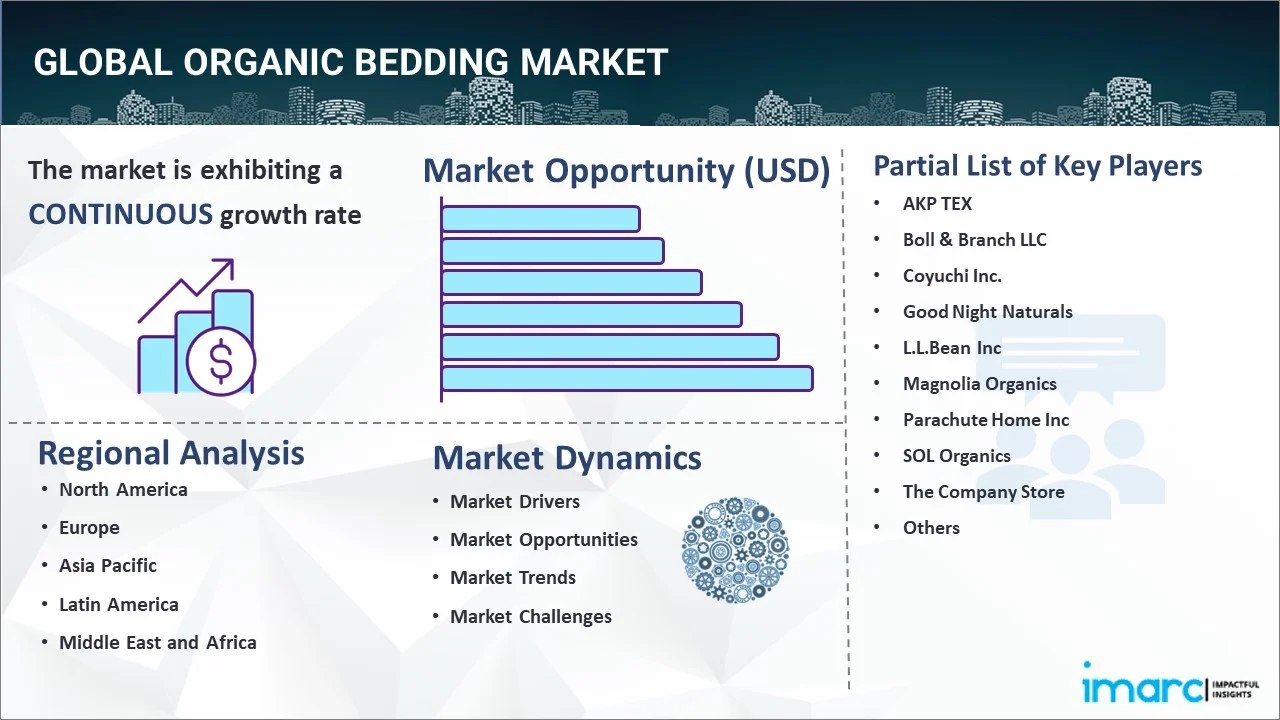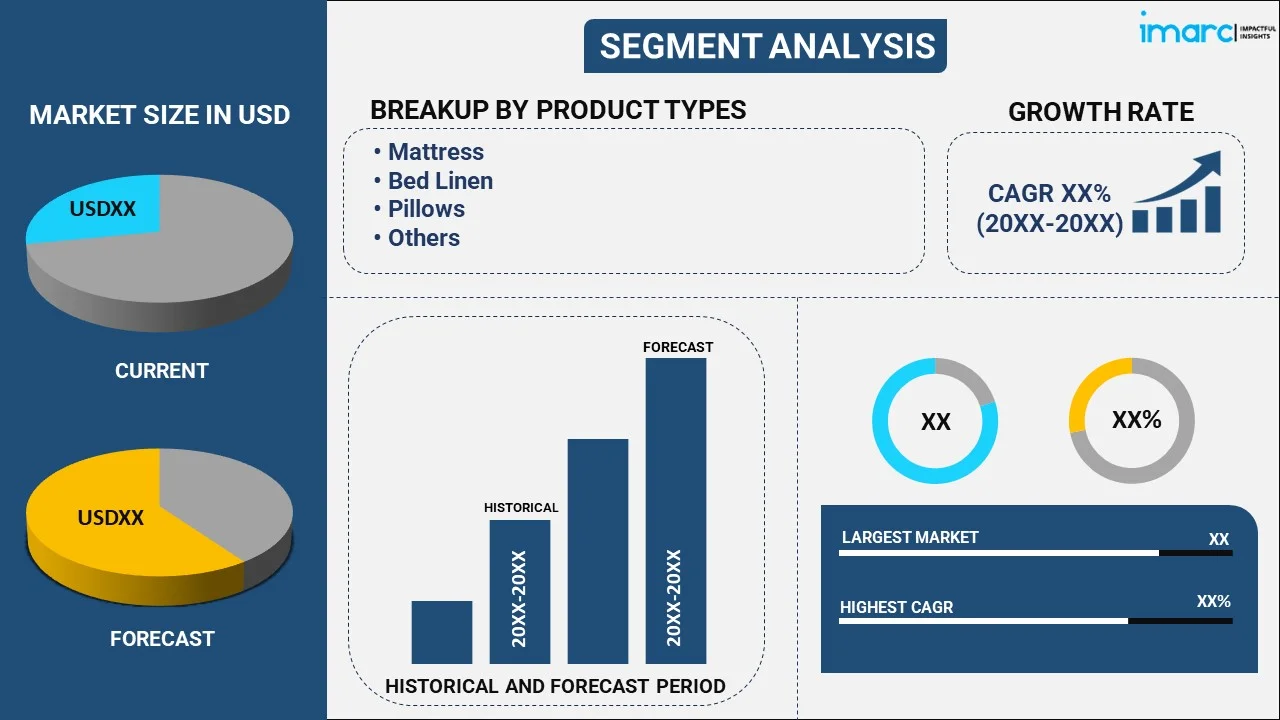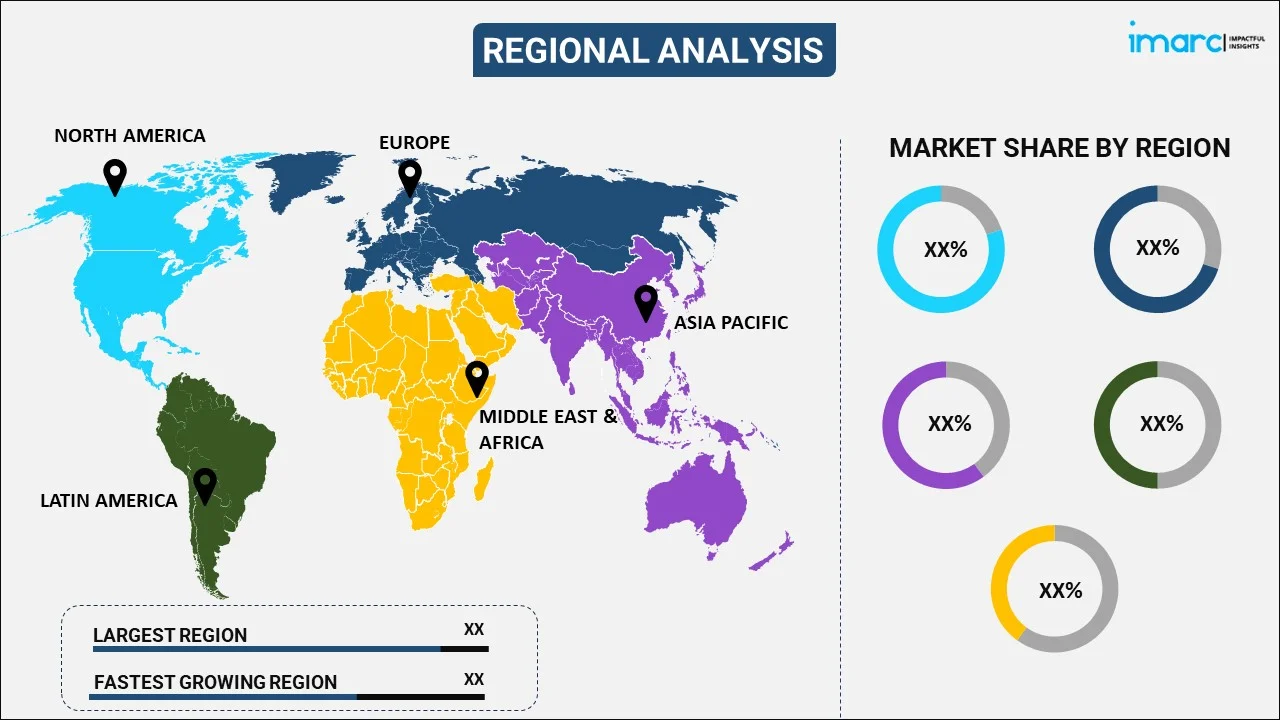
Organic Bedding Market Report by Product Type (Mattress, Bed Linen, Pillows, Blankets, and Others), Material (Cotton, Linen, and Others), End User (Residential, Commercial), Distribution Channel (Hypermarkets and Supermarkets, Specialty Stores, Online Channels), and Region 2025-2033
Organic Bedding Market Size:
The global organic bedding market size reached USD 531.3 Million in 2024. Looking forward, IMARC Group expects the market to reach USD 942.0 Million by 2033, exhibiting a growth rate (CAGR) of 6.24% during 2025-2033. The market is being driven by the growing awareness about the benefits of organic products and the increasing demand for eco-friendly and sustainable items. At present, North America holds the largest market share, driven by favorable government initiatives promoting organic farming and increasing purchasing power of consumers.
|
Report Attribute
|
Key Statistics
|
|---|---|
|
Base Year
|
2024 |
|
Forecast Years
|
2025-2033
|
|
Historical Years
|
2019-2024
|
| Market Size in 2024 | USD 531.3 Million |
| Market Forecast in 2033 | USD 942.0 Million |
| Market Growth Rate (2025-2033) | 6.24% |
Organic bedding refers to bedding made from natural materials, such as cotton, linen, wool, or silk, that are produced using sustainable farming methods without employing synthetic fertilizers, pesticides, or genetically modified organisms (GMOs). It is widely popular among people with sensitive skin or allergies, as organic materials are less likely to cause skin irritation or allergic reactions. In addition to this, organic bedding is often manufactured using environmentally friendly processes and packaging materials, making it a more sustainable and eco-friendly choice. There are several types of organic bedding available, including organic cotton sheets, wool comforters, and silk pillowcases. These products are often more expensive than conventional bedding; however, it is highly preferred by consumers who value ethical and sustainable products.

Organic Bedding Market Trends:
Widespread product adoption due to escalating consumer awareness and concerns about the impact of bedding materials obtained through conventional farming methods on the environment and human health represents the prime factor driving the market growth. Besides this, several governments around the globe are implementing stringent regulations promoting the adoption of organic farming and sensitizing the benefits of using organic products, which, in turn, is propelling the market forward. Moreover, the rising demand for environmentally friendly and sustainable products, as consumers have become more conscious of their purchasing choices, is creating a favorable outlook for the market. In line with this, rapid urbanization, the inflating disposable income of consumers, the growing adoption of high-end lifestyles, and the surging demand for luxurious and quality lifestyle products are presenting remunerative growth opportunities for the market. In addition to this, the shifting preference for natural and non-toxic bedding materials free from harmful chemicals and toxins often found in conventional product variants is acting as a significant growth-inducing factor. Concurrent with this, the expanding prevalence of allergies and sensitivities is making organic bedding more attractive, thus favoring the market growth. Apart from this, easy product availability through online channels, the emerging trends of home decor and interior design, and extensive investments in marketing and promotional activities are positively impacting the market growth.
Organic Bedding Market Segmentation:
IMARC Group provides an analysis of the key trends in each segment of the global organic bedding market report, along with forecasts at the global, regional, and country levels for 2025-2033. Our report has categorized the market based on product type, material, end user, and distribution channel.
Product Type Insights:

- Mattress
- Bed Linen
- Pillows
- Blankets
- Others
Bed linen accounts for the majority of the market share
The report has provided a detailed breakup and analysis of the organic bedding market based on the product type. This includes mattress, bed linen, pillows, blankets, and others. According to the report, bed linen represented the largest segment.
Bed linen is primarily driven by the growing consumer inclination toward sustainable and eco-friendly materials. Additionally, organic bed linen including sheets, duvet covers, and pillowcases manufactured from natural fibers like organic cotton, bamboo, and linen, is gaining popularity owing to its softness, hypoallergenic properties, and environmental benefits. Furthermore, customers are becoming aware about the materials used in beds owing to the comfort, longevity, and environmental benefits of organic cotton, linen, and bamboo textiles. Besides, the market for organic bed linens is fueled by growing interest in health and wellbeing as well as growing awareness about chemical-free textiles.
Material Insights:
- Cotton
- Linen
- Others
Cotton holds the largest share of the industry
A detailed breakup and analysis of the organic bedding market based on the material has also been provided in the report. This includes cotton, linen, and others. According to the report, cotton accounted for the largest market share.
Cotton holds the largest share due to its widespread adoption and consumers' preference for comfort and breathability. Furthermore, cotton is gaining traction as it is free from any dangerous chemicals or pesticides, which makes it a better choice for the environment and consumers. Besides, the increasing consumer awareness about eco-friendly and sustainable products is fueling the market for bedding made of organic cotton. Along with this, cotton is appealing due to its softness, resilience, and moisture-wicking qualities, which in turn is creating a positive market outlook.
End User Insights:
- Residential
- Commercial
Residential represents the leading market segment
The report has provided a detailed breakup and analysis of the organic bedding market based on the end user. This includes residential and commercial. According to the report, residential represented the largest segment.
The residential segment is driven by increasing consumer awareness about health, environmental sustainability, and the benefits of organic materials. Additionally, homeowners are opting for organic bedding to avoid exposure to harmful chemicals found in conventional textiles. Moreover, organic bedding’s hypoallergenic properties, chemical-free production, and natural materials appeal to families, especially those with young children or sensitive skin. Besides, the rise in disposable income and growing preference for eco-friendly products contributed to the popularity of organic bedding in households. Besides, the residential segment benefits from various products, including organic sheets, mattresses, and pillowcases, catering to several consumer preferences.
Distribution Channel Insights:
- Hypermarkets and Supermarkets
- Specialty Stores
- Online Channels
Specialty stores exhibits a clear dominance in the market
A detailed breakup and analysis of the organic bedding market based on the distribution channel has also been provided in the report. This includes hypermarkets and supermarkets, specialty stores, and online channels. According to the report, specialty stores accounted for the largest market share.
Specialty stores hold the largest share due to their focus on premium and eco-friendly products, offering a wide range of organic bedding options. Additionally, consumers are increasingly drawn to specialty stores for personalized service, expert advice, and the assurance of product authenticity. These stores often provide a curated selection of high-quality, sustainable bedding, catering to environmentally conscious buyers. Moreover, the growing preference for organic and chemical-free home products has further increased the demand for organic bedding in specialty retail outlets.
Regional Insights:

- North America
- United States
- Canada
- Europe
- Germany
- France
- United Kingdom
- Italy
- Spain
- Others
- Asia Pacific
- China
- Japan
- India
- South Korea
- Australia
- Indonesia
- Others
- Latin America
- Brazil
- Mexico
- Others
- Middle East and Africa
North America leads the market, accounting for the largest organic bedding market share
The report has also provided a comprehensive analysis of all the major regional markets, which include North America (the United States and Canada); Europe (Germany, France, the United Kingdom, Italy, Spain, and others); Asia Pacific (China, Japan, India, South Korea, Australia, Indonesia, and others); Latin America (Brazil, Mexico, and others); and the Middle East and Africa. According to the report, North America was the largest market for organic bedding. Some of the factors driving the North America organic bedding market included the rising demand for organic and sustainable bedding products, favorable government initiatives promoting organic farming, and the increasing purchasing powers of consumers.
Competitive Landscape:
The market research report has also provided a comprehensive analysis of the competitive landscape in the market. Detailed profiles of all major companies have also been provided. Some of the organic bedding companies covered include:
- AKP TEX
- Boll & Branch LLC
- Coyuchi Inc.
- Good Night Naturals
- L.L.Bean Inc
- Magnolia Organics
- Parachute Home Inc
- SOL Organics
- The Company Store
- The Natural Sleep Store
- The Organic Mattress
- WJ Southard
Kindly note that this only represents a partial list of companies, and the complete list has been provided in the report.
Organic Bedding Market Report Scope:
| Report Features | Details |
|---|---|
| Base Year of the Analysis | 2024 |
| Historical Period | 2019-2024 |
| Forecast Period | 2025-2033 |
| Units | Million USD |
| Scope of the Report | Exploration of Historical Trends and Market Outlook, Industry Catalysts and Challenges, Segment-Wise Historical and Future Market Assessment:
|
| Product Types Covered | Mattress, Bed Linen, Pillows, Blankets, Others |
| Materials Covered | Cotton, Linen, Others |
| End Users Covered | Residential, Commercial |
| Distribution Channels Covered | Hypermarkets and Supermarkets, Specialty Stores, Online Channels |
| Regions Covered | Asia Pacific, Europe, North America, Latin America, Middle East and Africa |
| Countries Covered | United States, Canada, Germany, France, United Kingdom, Italy, Spain, China, Japan, India, South Korea, Australia, Indonesia, Brazil, Mexico |
| Companies Covered | AKP TEX, Boll & Branch LLC, Coyuchi Inc., Good Night Naturals, L.L.Bean Inc, Magnolia Organics, Parachute Home Inc, SOL Organics, The Company Store, The Natural Sleep Store, The Organic Mattress, WJ Southard, etc. |
| Customization Scope | 10% Free Customization |
| Post-Sale Analyst Support | 10-12 Weeks |
| Delivery Format | PDF and Excel through Email (We can also provide the editable version of the report in PPT/Word format on special request) |
Key Questions Answered in This Report:
- How has the global organic bedding market performed so far, and how will it perform in the coming years?
- What are the drivers, restraints, and opportunities in the global organic bedding market?
- What is the impact of each driver, restraint, and opportunity on the global organic bedding market?
- What are the key regional markets?
- Which countries represent the most attractive organic bedding market?
- What is the breakup of the market based on the product type?
- Which is the most attractive product type in the organic bedding market?
- What is the breakup of the market based on the material?
- Which is the most attractive material in the organic bedding market?
- What is the breakup of the market based on the end user?
- Which is the most attractive end user in the organic bedding market?
- What is the breakup of the market based on the distribution channel?
- Which is the most attractive distribution channel in the organic bedding market?
- What is the competitive structure of the global organic bedding market?
- Who are the key players/companies in the global organic bedding market?
Key Benefits for Stakeholders:
- IMARC’s industry report offers a comprehensive quantitative analysis of various market segments, historical and current market trends, market forecasts, and dynamics of the organic bedding market from 2019-2033.
- The research report provides the latest information on the market drivers, challenges, and opportunities in the global organic bedding market.
- The study maps the leading, as well as the fastest-growing, regional markets. It further enables stakeholders to identify the key country-level markets within each region.
- Porter's five forces analysis assists stakeholders in assessing the impact of new entrants, competitive rivalry, supplier power, buyer power, and the threat of substitution. It helps stakeholders to analyze the level of competition within the organic bedding industry and its attractiveness.
- The competitive landscape allows stakeholders to understand their competitive environment and provides insight into the current positions of key players in the market.
Need more help?
- Speak to our experienced analysts for insights on the current market scenarios.
- Include additional segments and countries to customize the report as per your requirement.
- Gain an unparalleled competitive advantage in your domain by understanding how to utilize the report and positively impacting your operations and revenue.
- For further assistance, please connect with our analysts.
 Inquire Before Buying
Inquire Before Buying
 Speak to an Analyst
Speak to an Analyst
 Request Brochure
Request Brochure
 Request Customization
Request Customization




.webp)




.webp)












